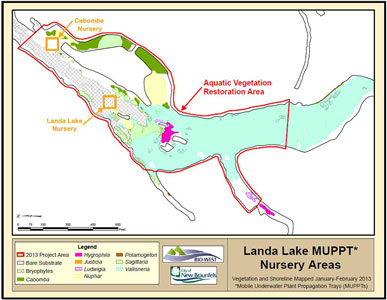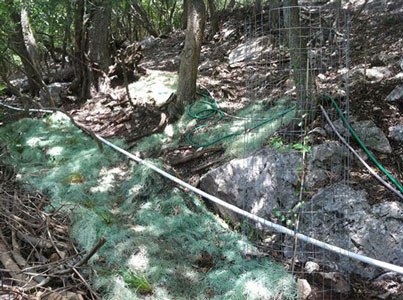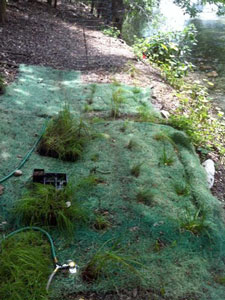Landa Lake Restoration
BIO-WEST developed and implemented a restoration plan to increase and improve habitat for fountain darter (Etheostoma fonticola) and other native aquatic fauna in Landa Lake, an 18-acre, spring-fed impoundment that is headwaters to the Comal River. Prior to implementation, areas that had previously been occupied by native aquatic plants had become scoured or over run with Indian swampweed (Hygrophila polysperma). Project goals were to reintroduce native aquatic plants, such as Carolina fanwort (Cabomba caroliniana) and creeping primrose-willow (Ludwigia repens) into scoured areas and revegetate areas occupied by Indian swampweed with creeping primrose-willow. Project-specific methods and equipment, including specialized mobile underwater plant propagation trays, were devised to propagate desired native aquatic plants and techniques were developed to effectively remove Indian swampweed. Sixty percent of the Indian swampweed was removed and over 2,800 native aquatic plants were installed in the restoration area. Project components included pre-restoration mapping of aquatic vegetation in GIS, site analysis for determination of suitable planting locations, monthly monitoring of planted sites, post-restoration mapping in GIS, and gardening and maintenance. BIO-WEST updated the City of New Braunfels and the Edwards Aquifer Authority Habitat Conservation Plan Science Committee on progress of restoration activities during the project and coordinated with the Center for Reservoir and Aquatic Ecosystem Research at Baylor University, Texas Parks and Wildlife Department, US Fish and Wildlife Service, and the San Marcos Aquatic Resource Center.
Landa Lake Restoration
 BIO-WEST developed and implemented a restoration plan to increase and improve habitat for fountain darter (Etheostoma fonticola) and other native aquatic fauna in Landa Lake, an 18-acre, spring-fed impoundment that is headwaters to the Comal River. Prior to implementation, areas that had previously been occupied by native aquatic plants had become scoured or over run with Indian swampweed (Hygrophila polysperma). Project goals were to reintroduce native aquatic plants, such as Carolina fanwort (Cabomba caroliniana) and creeping primrose-willow (Ludwigia repens) into scoured areas and revegetate areas occupied by Indian swampweed with creeping primrose-willow. Project-specific methods and equipment, including specialized mobile underwater plant propagation trays, were devised to propagate desired native aquatic plants and techniques were developed to effectively remove Indian swampweed. Sixty percent of the Indian swampweed was removed and over 2,800 native aquatic plants were installed in the restoration area. Project components included pre-restoration mapping of aquatic vegetation in GIS, site analysis for determination of suitable planting locations, monthly monitoring of planted sites, post-restoration mapping in GIS, and gardening and maintenance. BIO-WEST updated the City of New Braunfels and the Edwards Aquifer Authority Habitat Conservation Plan Science Committee on progress of restoration activities during the project and coordinated with the Center for Reservoir and Aquatic Ecosystem Research at Baylor University, Texas Parks and Wildlife Department, US Fish and Wildlife Service, and the San Marcos Aquatic Resource Center.
BIO-WEST developed and implemented a restoration plan to increase and improve habitat for fountain darter (Etheostoma fonticola) and other native aquatic fauna in Landa Lake, an 18-acre, spring-fed impoundment that is headwaters to the Comal River. Prior to implementation, areas that had previously been occupied by native aquatic plants had become scoured or over run with Indian swampweed (Hygrophila polysperma). Project goals were to reintroduce native aquatic plants, such as Carolina fanwort (Cabomba caroliniana) and creeping primrose-willow (Ludwigia repens) into scoured areas and revegetate areas occupied by Indian swampweed with creeping primrose-willow. Project-specific methods and equipment, including specialized mobile underwater plant propagation trays, were devised to propagate desired native aquatic plants and techniques were developed to effectively remove Indian swampweed. Sixty percent of the Indian swampweed was removed and over 2,800 native aquatic plants were installed in the restoration area. Project components included pre-restoration mapping of aquatic vegetation in GIS, site analysis for determination of suitable planting locations, monthly monitoring of planted sites, post-restoration mapping in GIS, and gardening and maintenance. BIO-WEST updated the City of New Braunfels and the Edwards Aquifer Authority Habitat Conservation Plan Science Committee on progress of restoration activities during the project and coordinated with the Center for Reservoir and Aquatic Ecosystem Research at Baylor University, Texas Parks and Wildlife Department, US Fish and Wildlife Service, and the San Marcos Aquatic Resource Center.


BIO-WEST developed and implemented a restoration plan to increase and improve habitat for fountain darter (Etheostoma fonticola) and other native aquatic fauna in Landa Lake, an 18-acre, spring-fed impoundment that is headwaters to the Comal River. Prior to implementation, areas that had previously been occupied by native aquatic plants had become scoured or over run […]
